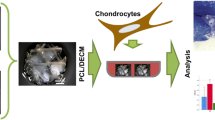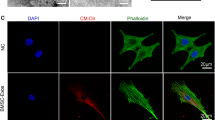Abstract
Tissue engineering of cartilage tissue offers a promising method for reconstructing ear, nose, larynx and trachea defects. However, a lack of sufficient nutrient supply to cartilage constructs limits this procedure. Only a few animal models exist to vascularize the seeded scaffolds. In this study, polycaprolactone (PCL)-based polyurethane scaffolds are seeded with 1 × 106 human cartilage cells and implanted in the right hind leg of a nude mouse using an arteriovenous flow-through vessel loop for angiogenesis for the first 3 weeks. Equally seeded scaffolds but without access to a vessel loop served as controls. After 3 weeks, a transposition of the vascularized scaffolds into the groin of the nude mouse was performed. Constructs (verum and controls) were explanted 1 and 6 weeks after transposition. Constructs with implanted vessels were well vascularized. The amount of cells increased in vascularized constructs compared to the controls but at the same time noticeably less extracellular matrix was produced. This mouse model provides critical answers to important questions concerning the vascularization of engineered tissue, which offers a viable option for repairing defects, especially when the desired amount of autologous cartilage or other tissues is not available and the nutritive situation at the implantation site is poor.







Similar content being viewed by others
References
Baek CH, Ko YJ (2006) Characteristics of tissue-engineered cartilage on macroporous biodegradable PLGA scaffold. Laryngoscope 116:1829–1834
Cronin KJ, Messina A, Knight KR, Cooper-White JJ, Stevens GW, Penington AJ, Morrison WA (2004) New murine model of spontaneous autologous tissue engineering, combining an arteriovenous pedicle with matrix materials. Plast Reconstr Surg 113:260–269
Eyrich D, Wiese H, Maier G, Skodacek D, Appel B, Sarhan H, Tessmar J, Staudenmaier R, Wenzel MM, Goepferich A, Blunk T (2007) In vitro and in vivo cartilage engineering using a combination of chondrocyte-seeded long-term stable fibrin gels and polycaprolactone-based polyurethane scaffolds. Tissue Eng 13:2207–2218
Folkman J, Hochberg M (1973) Self-regulation of growth in three dimensions. J Exp Med 138:745–753
Freed LE, Marquis JC, Langer R, Vunjak-Novakovic G, Emmanual J (1994) Composition of cell-polymer cartilage implants. Biotechnol Bioeng 43:605–614
Grad S, Kupcsik L, Gorna K, Gogolewski S, Alini M (2003a) The use of biodegradable polyurethane scaffolds for cartilage tissue engineering: potential and limitations. Biomaterials 24:5163–5171
Grad S, Zhou L, Gogolewski S, Aini M (2003b) Chondrocytes seeded onto poly (L/DL-lactide) 80 %/20% porous scaffolds: a biochemical evaluation. J Biomed Mater Res 66:571–579
Hirase Y, Valauri FA, Buncke HJ (1988) Prefabricated sensate myocutaneus and osteomyocutaneous free flaps: an experimental model. Preliminary report. Plast Reconstr Surg 82:440–446
Hoang NT, Kloeppel M, Staudenmaier R, Werner J, Biemer E (2005a) Prefabrication of large fasciocutaneus flaps using an isolated arterialised vein as implanted vascular pedicle. Br J Plast Surg 58:632–639
Hoang NT, Kloeppel M, Staudenmaier R, Schweinbeck S, Biemer E (2005b) Neovascularization in prefabricated flaps using a tissue expander and an implanted arteriovenous pedicle. Microsurgery 25:213–219
Hoang NT, Hoehnke C, Hien PT, Mandlik V, Feucht A, Staudenmaier R (2009) Neovascularization and free microsurgical transfer of in vitro cartilage-engineered constructs. Microsurgery 29:52–61
Huang CY, Reuben PM, D’Ippolito G, Schiller PC, Cheung HS (2004) Chondrogenesis of human bone marrow-derived mesenchymal stem cells in agarose culture. Anat Rec A 278:428–436
Hutmacher DW (2000) Scaffolds in tissue engineering bone and cartilage. Biomaterials 21:2529–2543
Itoh Y (1992) An experimental study of prefabricated flaps using silicone sheets, with reference to the vascular patternization process. Ann Plast Surg 28:140–146
Iwasa J, Ochi M, Uchio Y, Katsube K, Adachi N, Kawasaki K (2003) Effekts of cell density on proliferation and matrix synthesis of chondrocytes embedded in atelocollagen gel. Artif Organs 27:249–255
Kamil SH, Kojima K, Vacanti MP, Zaparojan V, Vacanti CA, Eavey RD (2007) Tissue engineered cartilage: utilization of autologous serum and serum-free media for chondrocyte culture. Int J Pediatr Otorhinolaryngol 71:71–75
Khouri RK, Koudsi B, Deune EG (1993) Tissue generation with growth factors. Surgery 114:374–379
Kim YJ, Sah RL, Doong JY, Grodzinsky AJ (1988) Fluorometric assay of DNA in cartilage explants using hoechst 33258. Anal Biochem 174:168–176
Levenberg S (2005) Engineering blood vessels from stem cells: recent advances and applications. Curr Opin Biotechnol 16:516–523
Morrison WA, Dvir E, Doi K, Hurley JV, Hickey MJ, O’Brien BM (1990) Prefabrication of thin transferable axial-pattern skin flaps: an experimental study in rabbits. Br J Plast Surg 43:645–654
Morrison WA, Penington AJ, Kumta SK, Callan P (1997) Clinical applications and technical limitations of prefabricated flaps. Plast Reconstr Surg 99:378–385
Mueller FA, Mueller L, Hofmann I, Greil P, Wenzel MM, Staudenmaier R (2006) Cellulose-based scaffold materials for cartilage tissue engineering. Biomaterials 27:3955–3963
Neumeister MW, Wu T, Chambers C (2006) Vascularized tissue-engineered ears. Plast Reconstr Surg 117:116–122
Nguyen NT, Kloeppel M, Staudenmaier R, Werner J, Biemer E (2005) Study of the neovascularisation of prefabricated flaps using a silicone sheet and an isolated arterial pedicle: experimental study in rabbits. Scand J Plast Reconstr Surg Hand Surg 39:326–333
Nomi M, Atala A, De Coppi P, Soker S (2002) Principals of neovascularization for tissue engineering. Mol Asp Med 23:463–483
Pribaz JJ, Fine NA (1994) Prelamination: defining the prefabricated flap – a case report and review. Microsurgery 15:618–623
Pribaz JJ, Fine NA (2001) Prefabricated and prelaminated flaps for head and neck reconstruction. Clin Plast Surg 28:261–272
Sahoo S, Ang LT, Goh JC, Toh SL (2010) Growth factor delivery through electrospun nanofibers in scaffolds for tissue engineering applications. J Biomed Mater Res 93:1539–1550
Shen TY (1982) Microvascular transplantation of prefabricated free thigh flap (letter). Plast Reconstr Surg 69:568
Staudenmaier R, Hoang TN, Kleinsasser N, Schurr C, Frölich K, Wenzel MM, Aigner J (2004) Flap prefabrication and prelamination with tissue-engineered cartilage. J Reconstr Microsurg 20:555–564
Takato T, Komuro Y, Yonehara H, Zuker RM (1993) Prefabricated venous flaps: an experimental study in rabbits. Br J Plast Surg 46:122–126
Tan BK, Chen HC, He TM, Song IC (2004) Flap prefabrication - The bridge between conventional flaps and tissue-engineered flaps. Ann Acad Med 33:662–666
Tanaka Y, Sung KC, Tsutsumi A, Ohba S, Ueda K, Morrison WA (2003) Tissue engineering skin flaps: Which vascular carrier, arteriovenous shunt loop or arteriovenous bundle, has more potential for angiogenesis and tissue generation? Plast Reconstr Surg 112:1626–1644
Wiggenhauser PS, Müller DF, Melchels FPW, Egana JT, Storck K, Mayer H, Leuthner P, Skodacek D, Hopfner U, Machens HG, Staudenmaier R, Schantz JT (2012) Engineering of vascularized adipose constructs. Cell Tissue Res 347:747–757
Yamamoto K, Tomita N, Fukuda Y, Suzuki S, Igarashi N, Suguro T, Tamada Y (2007) Time-dependent changes in adhesive force between chondrocytes and silk fibroin substrate. Biomaterials 28:1838–1846
Yamamura N, Sudo R, Ikeda M, Tanishita K (2007) Effects of the mechanical properties of collagen gel on the in vitro formation of microvessel networks by endothelial cells. Tissue Eng 13:1443–1453
Author information
Authors and Affiliations
Corresponding author
Rights and permissions
About this article
Cite this article
Burghartz, M., Gehrke, T., Storck, K. et al. Vascularization of engineered cartilage constructs in a mouse model. Cell Tissue Res 359, 479–487 (2015). https://doi.org/10.1007/s00441-014-2026-2
Received:
Accepted:
Published:
Issue Date:
DOI: https://doi.org/10.1007/s00441-014-2026-2




